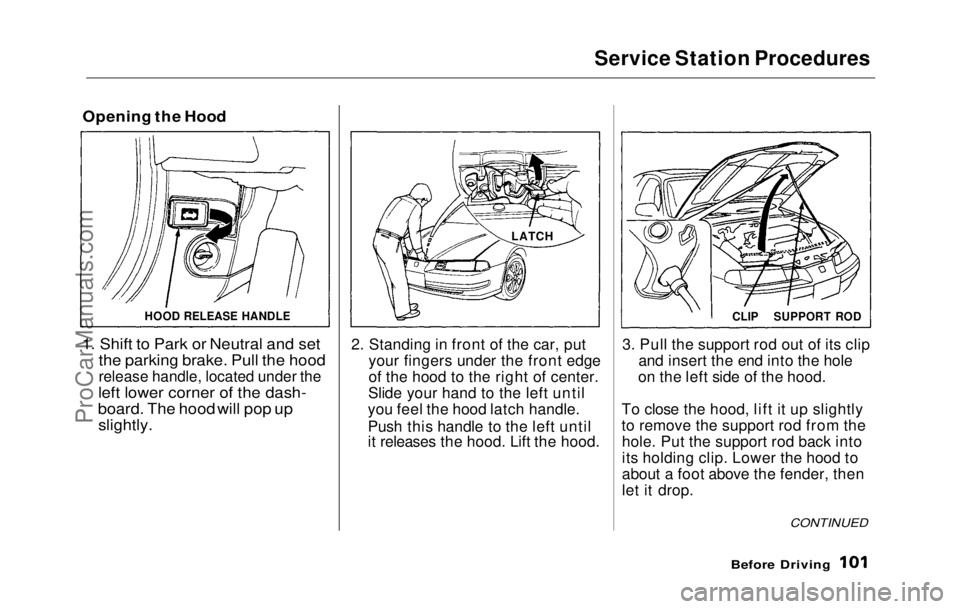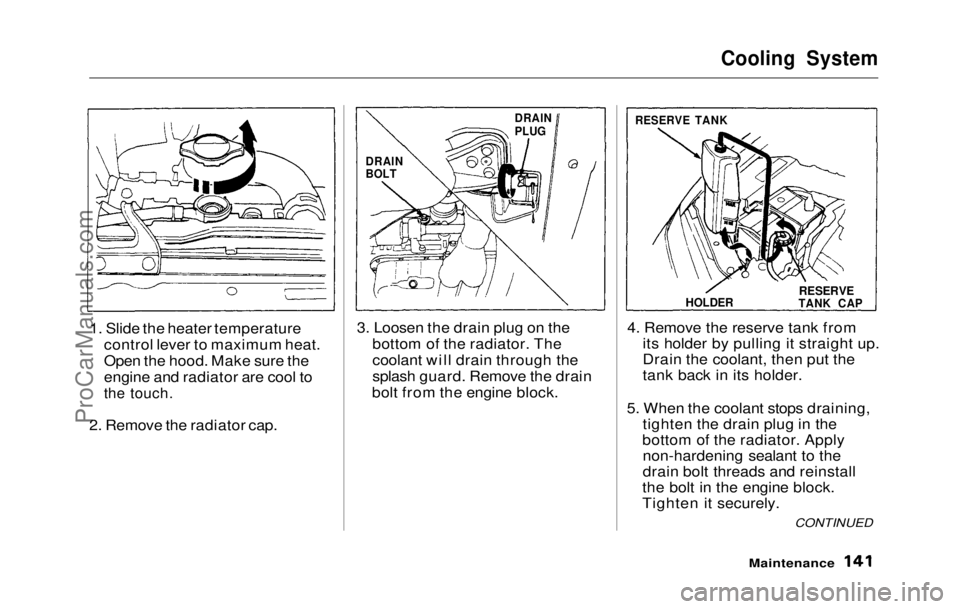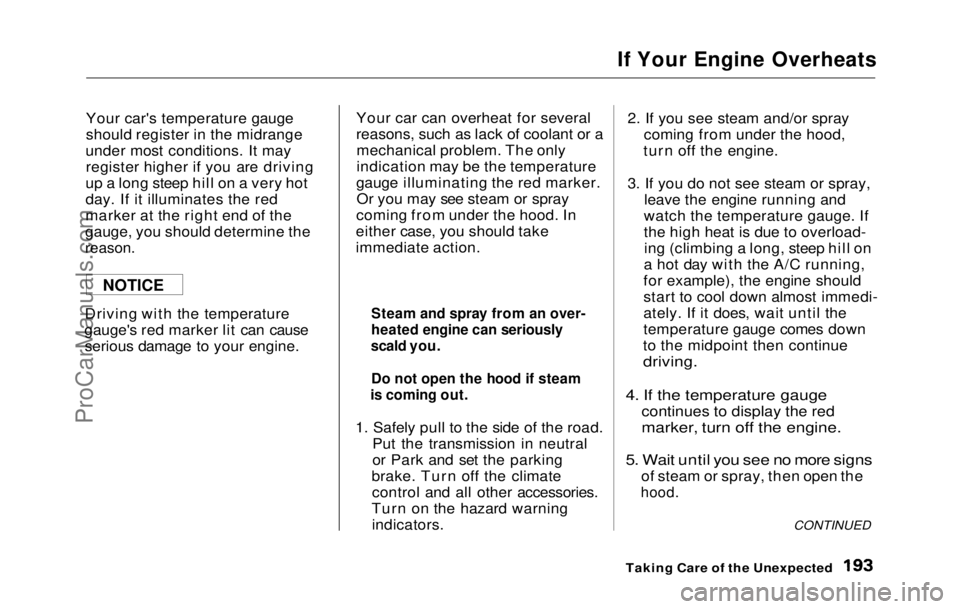1992 HONDA PRELUDE open hood
[x] Cancel search: open hoodPage 96 of 225

Before Driving
Before you begin driving your
Honda, you should know what gaso-
line to use, and that your car is full
of oil and other important fluids.
You also need to know how to pro-
perly stow luggage or packages.
This section will help you. If you plan to add any accessories to your
car, please read the informatio n in
this section
first.
Break-in Period .............................. 98
Gasoline........................................... 98
Oxygenated Fuels...................... 98
Driving in Foreign Countries... 99
Service Station Procedures........ 100 Filling the Gas Tank ............... 100
Opening the Hood....................
101
Fuel Economy
.............................. 104
Vehicle Condition..................... 104
Driving Habits.......................... 104
Accessories................................... 105
Loading Cargo.............................. 106
Before DrivingProCarManuals.comMain Menu s t
Page 100 of 225

Service Station Procedures
Opening the Hood
1. Shift to Park or Neutral and set
the parking brake. Pull the hood
release handle, located under the
left lower corner of
the dash-
board. The hood will pop up slightly.
2. Standing
in front of the car, put
your fingers under the front edge
of the hood to the right of center.
Slide your hand to the left until
you feel the hood latch handle.
Push this handle to the left until
it releases the hood. Lift the hood.
3. Pul l
the support rod out of its clip
and insert the end into the hole
on the left side of the hood.
To close the hood, lift it up slightly
to remove the support rod from the hole. Put the support rod back into
its holding clip. Lower the hood to
about a foot above the fender, then
let it drop.
Before Driving
HOOD RELEASE HANDLE
LATCH
CONTINUED
CLIP
SUPPORT RODProCarManuals.comMain Menu Table of Contents s t
Page 135 of 225

Engine Oil
Oil and Filter Changes
Always change the oil and filter according to the time and mileage
recommendations on the mainte-
nance schedule. The oil and filter collect contaminants that can dam-
age your engine if they are not
removed regularly. Changing the oil and filter requires
special tools and access from
underneath the car. The car should
be raised on a service station-type
hydraulic lift for this service. Unless you have the knowledge
and proper equipment, you should
have this maintenance done by a
skilled mechanic. 1. Run the engine until it reaches
normal operating temperature,
then shut it off. 2. Open the hood and remove the oil
filler cap. Remove the oil drain
bolt from the bottom of the
engine. Drain the oil into an
appropriate container.
3. Remove the oil filter and let the remaining oil drain. A special
wrench (available from your Honda dealer) is required to
remove the filter.
Maintenance
CONTINUED
The oil, engine components
and the exhaust system are
hot and can burn you.
Use caution and wear protec-
tive clothing while working in
the engine compartment.
Repeated, prolonged exposure
to used motor oil may cause
skin cancer.
Wash your hands thoroughly
with strong soap as soon as possible after handling used oil. OIL FILTER
OIL DRAIN BOLTProCarManuals.comMain Menu Table of Contents s t
Page 139 of 225

Cooling System
1. Slide the heater temperature control lever to maximum heat.
Open the hood. Make sure the
engine and radiator are cool to
the touch.
2. Remove the radiator cap. 3. Loosen the drain plug on the
bottom of the radiator. The
coolant will drain through the
splash guard. Remove the drain
bolt from the engine block. 4. Remove the reserve tank from
its holder by pulling it straight up.
Drain the coolant, then put the
tank back in its holder.
5. When the coolant stops draining, tighten the drain plug in the
bottom of the radiator. Apply non-hardening sealant to the
drain bolt threads and reinstall
the bolt in the engine block.
Tighten it securely.
Maintenance
DRAIN
PLUG
DRAIN
BOLT RESERVE TANK
HOLDER
RESERVE
TANK CAP
CONTINUEDProCarManuals.comMain Menu Table of Contents s t
Page 162 of 225

Lights
Check the operation of your car's
exterior lights at least once a
month. A burned out bulb can
create an unsafe condition by
reducing your car's visibility and
the ability to signal your intentions
to other drivers. Check the following:
Headlights (low and high beam) Parking lights
Taillights
Brake lights
High-mount brake light
Turn signals Back-up lights
Hazard light function
License plate light
Side marker lights
Daytime running lights
(Canadian cars)
If you find any
bulbs are burned
out, replace them as soon as
possible. Refer to the chart on page
207 to determine what
type of
replacement bulb is needed.
Replacing a Headligh
t Bulb
Your car has two bulbs on each
side, four in total. Make sure you
are replacing the bulb that is
burned out. Your car uses halogen
headlight bulbs. When replacing a
bulb, handle it by its plastic case
and protect the glass from contact
with your skin or hard objects. If
you touch the glass, clean it with
denatured alcohol and a clean cloth.
Halogen headlight bulbs get very
hot when lit. Oil, perspiration, or a
scratch on the glass can cause the
bulb to overheat and shatter.
1. Open the hood.
If you need to change the high
beam headlight bulb
on
the
passenger's side, remove the
radiator reserve tank by pulling
it straight up.
2. To disconnect the bulb from the
electrical harness, push on the
end of the lock tab to release the
connector then push the connec-
tor straight down.
Maintenance
NOTICEProCarManuals.comMain Menu Table of Contents s t
Page 187 of 225

If Your Engine Won't Start, Jump Starting
The Starter Operates
Normally
In this case, the starter motor
sounds normal when you turn the
ignition switch to START (III), but
the engine does not run. Are you using the proper starting
procedure? Refer to Starting
the Engine on page 109 . Do you have gas? Turn the
ignition switch to ON (II) for a
minute and watch the fuel gauge.
There may be an electrical
problem, such as no power to the
fuel pump. Check all the fuses
(see page 199 ).
If you find nothing wrong, you will
need a qualified technician to find
the problem. See Towing on page
202.
Jump Starting
If your car's battery has run down,
you may be able to start the engine
by using a booster battery. Although this seems like a simple
procedure, there are several precau-
tions you should take. Follow the
directions closely.
You cannot start a Honda with an
automatic transmision by pushingor pulling it. To jump start your car:
1. Open the hood and check the physical condition of the battery
(see page 152 ). In very cold
weather, check the condition of the electrolyte. If it seems slushy
or like ice, do not try jump
starting until it thaws.
If a battery sits in extreme cold, the
electrolyte inside can freeze.
Attempting to jump start with a frozen battery can cause it to
rupture or explode.
2. Turn off all the electrical acces- sories: heater, A/C, stereo system,
lights, etc. Put the transmission in Neutral
or Park and set the parking
brake.
Taking Care of the Unexpected
CONTINUED
A battery can explode if you
do not follow the correct
procedure, seriously injuring
anyone nearby.
Keep all sparks, open flames,
and smoking materials away
from the battery.
NOTICE
ProCarManuals.comMain Menu Table of Contents s t
Page 189 of 225

If Your Engine Overheats
Your car's temperature gauge
should register in the midrange
under most conditions. It may register higher if you are driving
up a long steep hill on a very hot
day. If it illuminates the red
marker at the right end of the
gauge, you should determine the
reason.
Driving with the temperature
gauge's red marker lit can cause serious damage to your engine. Your car can overheat for several
reasons, such as lack of coolant or a
mechanical problem. The only
indication may be the temperature
gauge illuminating the red marker. Or you may see steam or spray
coming from under the hood. In
either case, you should take
immediate action.
1. Safely pull to the side of the road.
Put the transmission in neutral
or Park and set the parking
brake. Turn off the climate control and all other accessories.
Turn on the hazard warning indicators.
2. I f
you see steam and/or spray
coming from under the hood,
turn off the engine.
3. If you do not see steam or spray,
leave the engine running and
watch the temperature gauge. If
the high heat is due to overload- ing (climbing a long, steep hill on
a hot day with the A/C running,
for example), the engine should
start to cool down almost immedi-
ately. If it does, wait until the
temperature gauge comes down
to the midpoint then continue
driving.
4. If
the temperature gauge
continues to display the red
marker, turn off
the
engine.
5. Wait until you see no more signs
of steam or spray, then open the
hood.
Taking Care of the Unexpected
NOTICE
Steam and spray from an over-
heated engine can seriously
scald you.
Do not open the hood if steam
is coming out.
CONTINUEDProCarManuals.comMain Menu Table of Contents s t
Page 191 of 225

Low Oil Pressure
The low oil pressure light should never come on when the engine is
running. If this light comes on with
the engine running, take immediate
action.
Running the engine with low oil
pressure can cause serious mechani-
cal damage almost immediately.
Turn off the engine as soon as you
can safely get the car stopped. 1. Safely pull off the road and shut
off the engine.
2. Le
t
the car sit for a minute. Open
the hood and check the oil level
(see page 135). Although oil level
and oil pressure are not directly
connected, an engine that is very
low on oil can lose pressure
during cornering and other
driving maneuvers.
3. I f
necessary, add oil to bring the
level back to the full mark on the
dipstick (see page 135
).
4. Star t
the engine and watch the
oil pressure light. If the light
does not go out within ten
seconds, turn off the engine.
There is a mechanical problem
that needs to be repaired before
you can continue driving. (See
Towin g on
page 202 .
)
Taking Car e
of the Unexpected
LOW OIL PRESSURE LIGHT
NOTICEProCarManuals.comMain Menu Table of Contents s t